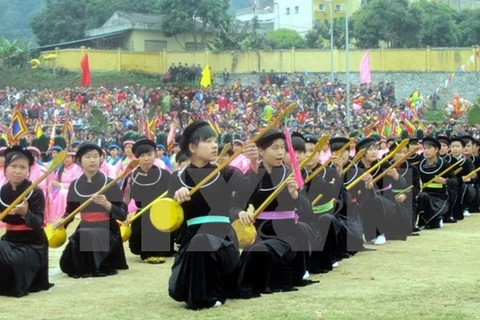Lang Son (VNA) – Lang Son province has encouraged the establishment of local Then singing clubs to promote the development of this genre of traditional singing – a typical culture of Tay, Nung and Thai ethnic people in the northern mountainous region.
Head of the provincial traditional singing and musical instrument club Trieu Thuy Tien said that the establishment of these clubs is a practical movement to help preserve and promote the value of Then singing, which is always accompanied by a handmade gourd lute called “Dan tinh” or “Tinh Tau”, in the locality.
Since its formation in 2009, the club has attracted over 300 members. The birth of the club has motivated the establishment of other Then singing clubs in Lang Son’s districts.
According to the provincial Department of Culture, Sports and Tourism, the province is home to 65 clubs with around 1,400 members.
Hoang Thi Thuy, member of Noc Kham Khac club in Na Sam town, Van Lang district, said that after nearly 5 years, her club now has 26 members who love Then singing and Dan Tinh at all age groups, from 10 to 78 years old.
Thuy expressed her hope that local authorities will organise more exchange programmes for clubs in order to offer amateur artists chances to meet and share experience.
To preserve and promote the value of this genre of singing, Tien stressed the need to maintain Tay and Nung languages in Then songs.
For Tay, Nung and Thai people, Then singing is an indispensable part of their religious and spiritual lives, even back when the art was on the brink of falling into oblivion.
According to researchers, the word “Then” originates from “Thien”, which means sky or heaven. Therefore, Then singing is regarded as a tune of the Gods by local ethnic people.
Music theorist Nguyen Thi Minh Chau from the Vietnam Association of Composers said Then was created by Tay, Nung and Thai ethnic groups.
Then is considered a spiritual product reflecting the social and cultural life of people with a special combination of literature, music and dance, she said.
Those practicing Then are labourers who understand local customs and carry out important rituals for communities and individuals in important periods of life. Thereby, Then is believed to derive from the working life of people, she added.
The most important figures in a Then singing performance are “Ong Then” and “Ba Then” who can sing, dance and play a musical instrument at the same time during rituals while presenting offerings to God, helping the ethnic community to ask for good health, bumper crops, happiness and a long life.
Then singing is practised in many northern provinces, including Cao Bang, Bac Kan, Thai Nguyen, Lang Son, Ha Giang, Quang Ninh, Son La, Lai Chau, Lao Cai, Bac Giang and Yen Bai, and the Central Highlands province of Dak Lak.
There are two types of Then singing: Then Ky Yen (praying for good things) and Then Le Hoi (Then festival). The first is performed at rituals while the latter is to bring cheer and drive away sorrow and hardships in life and is normally used in rituals to pray for good crops, enter a new home, or cap sac (coming-of-age).
The sixth edition of the National Festival of Traditional Then singing will take place on May 12-14 in the northern mountainous province of Ha Giang, as part of national culture, sports and tourism activities to honour, preserve and develop this traditional art form.
Art troupes from 14 provinces and cities where many Tay, Nung and Thai ethnic people reside such as Cao Bang, Ha Giang, Tuyen Quang, Bac Kan, Lang Son, Thai Nguyen, Bac Giang, Quang Ninh, Yen Bai, Lao Cai, Son La, Dien Bien, Lai Chau and Dak Lak, will perform different types of Then singing.
A series of events will be held during the festival such as performances of Then singing, a photo exhibition on Then cultural heritage and introduction of traditional weaving of Tay, Nung and Thai ethnic groups. Ha Giang – the host of the event will also take this occasion to organise activities to promote its tourism.
Last year, the Ministry of Culture, Sports and Tourism signed a dossier on Then singing for submission to UNESCO asking for the recognition of this art form as part of world intangible cultural heritage.-VNA
VNA























